Beef is one of the most commonly consumed and popular meats around the world. With so many different cuts of beef available, it can be challenging to know which are the best and how to cook them properly. To help make things easier, I’ve put together this guide that ranks and reviews some of the top cuts of beef, how to cook them, and what makes each stand out.
When evaluating beef cuts, important factors to consider include tenderness, flavor, fat marbling, preferred cooking methods, and price. Here are 10 of the best cuts of beef, ranked from first to last.
1. Ribeye
The ribeye steak, also known as scotch fillet or entrecôte, is my personal favorite and tops the list of best beef cuts. It comes from the rib primal section of the cow, specifically the longissimus dorsi muscle between the 6th and 12th ribs.
What makes ribeye so delicious is its extensive marbling, which gives it a rich, beefy flavor and incredibly tender and juicy texture. The high fat content in ribeye means it’s very forgiving and hard to overcook. Ribeye can be prepared using various cooking methods like grilling, pan searing, broiling, or roasting. While it’s one of the pricier cuts, ribeye is an excellent choice for a special meal and delivers the ultimate steak eating experience.
2. Tenderloin
Also known as filet mignon, the tenderloin is considered one of the most tender cuts of beef It comes from the short loin primal and contains very little connective tissue Tenderloin is prized for its melt-in-your-mouth texture, although it doesn’t have as much fat as ribeye, so the flavor is more subdued. It’s very lean and quick cooking, so be careful not to overcook it. Tenderloin is perfect for pan searing or grilling and pairing with a flavorful sauce or compound butter. It’s one of the most expensive cuts of beef.
3. Strip Steak
The strip steak, also called New York strip or Kansas City strip, comes from the short loin primal. It offers a perfect balance of tenderness and rich flavor, with a decent amount of marbling. Strip steak is very versatile and responds well to various cooking methods like grilling, broiling, pan searing, and roasting. It can be purchased bone-in or boneless. While it’s not as robust as ribeye, the strip steak is an excellent choice for those seeking great taste and tenderness.
4. Porterhouse
The porterhouse contains portions of two of the best steaks – the tenderloin and the strip steak separated by a T-shaped bone. It comes from the rear end of the short loin primal. You get the tenderloin on one side of the bone and the strip steak on the other combining the best of both worlds into one delicious cut. The large size makes porterhouse ideal for sharing. It’s one of the priciest cuts but special enough for an extraordinary meal.
5. T-Bone
Similar to the porterhouse, the T-bone contains parts of the tenderloin and strip steak connected by a T-shaped bone. It’s cut from the short loin closer to the front, so it features a smaller portion of tenderloin. Still, the T-bone offers a nice sampling of both steaks. It’s not quite as tender or well-marbled as the porterhouse but still an excellent quality cut for a memorable steak dinner.
6. Skirt Steak
The skirt steak comes from the diaphragm muscle and is packed with flavor. It does contain a lot of tough fibers, but marinating helps tenderize, and slicing against the grain maximizes tenderness. The thin profile makes skirt steak perfect for grilling or pan searing. It’s also very affordable, giving you great bang for your buck. Just be sure to avoid overcooking.
7. Flank Steak
Flank steak comes from the lower abdominal area of the cow. It has a distinct grain and robust beefy flavor. Slicing against the grain helps tenderize flank steak. Marinades and spices also work well with the flank’s flavor profile. Quick grilling or pan searing helps prevent the flank from becoming too tough. Overall, it provides a satisfying taste and texture at a budget-friendly price.
8. Flat Iron
This underrated cut comes from the top blade roast in the chuck primal. It’s nicely tender thanks to its modest marbling and lack of connective tissue. Flat iron steak has a rich, beefy flavor similar to ribeye but costs much less. It does well with most cooking methods but be careful not to overcook, as it can become chewy. For a great value steak with good tenderness and taste, flat iron is a winner.
9. Tri-Tip
From the bottom sirloin primal, tri-tip is a small triangular cut. It’s very lean and modestly tender but boasts big beefy flavors. Simple seasoning and high-heat grilling or broiling are best to bring out its taste. Letting tri-tip rest after cooking is also key. It’s a fantastic budget-friendly cut for grilling.
10. Chuck Eye
The chuck eye steak comes from the center of the chuck primal. It offers great marbling, juiciness, and flavor similar to ribeye but costs much less. However, it can be hit or miss depending on where exactly it’s cut from, as portions closer to the ribs tend to be more tender. When trimmed properly, chuck eye steak provides an excellent, inexpensive alternative to pricier steaks.
How to Cook Different Cuts of Beef
Now that you know the best cuts of beef, let’s discuss how to cook them to perfection. Keep these tips in mind:
-
Ribeye, strip, flat iron, and chuck eye do well with quick, dry-heat cooking like grilling, broiling, and pan searing. Cook over high heat for a nicely charred exterior while keeping a rarer interior.
-
Flank, skirt, and tri-tip also respond best to high-heat grilling, broiling, or pan searing. Slice against the grain after cooking. Marinades help tenderize flank and skirt.
-
Tenderloin should be cooked gently using lower heat methods like pan searing and grilling. Take care not to overcook this lean cut.
-
For porterhouse and T-bone, use evenly distributed heat like grilling or broiling to cook the tenderloin and strip portions evenly.
-
Allow all steaks to rest 5-10 minutes after cooking for juicier, more tender results.
-
Use a meat thermometer to monitor temperature and avoid over or undercooking.
-
Season simply with salt, pepper, herbs, and spices to let the natural beef flavors shine.
Things to Consider When Buying Beef
When shopping for beef, keep the following tips in mind:
-
Look for good marbling to ensure tender, flavorful meat. Heavily marbled cuts like ribeye generally deliver the best eating experience.
-
Look for beef that is bright cherry-red in color, which indicates proper aging and quality beef. Avoid any brown or gray coloring.
-
For the best texture and tenderness, choose thicker steaks whenever possible. Aim for 1-2 inches thick for cuts like ribeye, strip, and tenderloin.
-
High grade beef like Prime offers superior marbling, tenderness, and flavor over lower grades. It comes at a higher cost though.
-
Dry-aged beef develops deeper flavor over time but costs more. Wet-aged beef offers decent flavor at a lower price point.
-
Grass-fed and organic beef is perceived as healthier and more humane but is typically more expensive.
With this guide to the best cuts of beef and how to cook them, you can find and prepare the perfect steak for any occasion. From special dinners to weeknight meals, these tips will help you become a pro at cooking satisfying steaks. Enjoy exploring all the wonderful flavors and textures that beef has to offer.

Best Cuts of Steak in Order
We’ve arranged the top 10 best cuts of steak in order of quality so you can see the top contenders while picking what works best for your menu and target clientele.
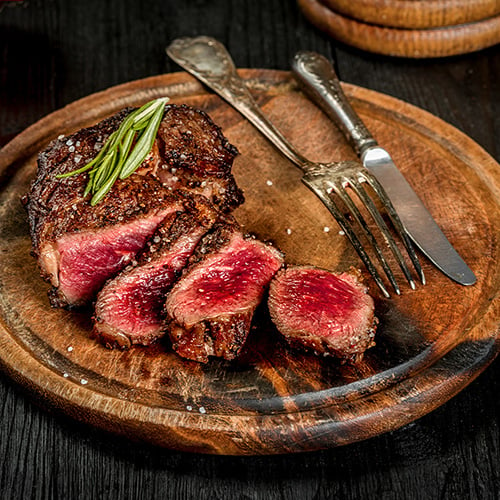
Filet mignon is considered one of the most luxurious and expensive beef cuts prized for its tender and buttery texture. It comes from the center cut of the tenderloin, which is a long, cylindrical muscle located along the spine of the cow. This muscle is not weight-bearing, which means it doesnt do much work during the cows lifetime. As a result, the meat from this area is incredibly tender. The name “filet mignon” is derived from French, with filet meaning “thick slice” and mignon meaning “dainty” or “delicate.” This name accurately describes the cut, as filet mignon is typically a small, round steak cut into thick slices.
One of the defining characteristics of filet mignon is its lack of fat marbling. Its prized for its lean and tender meat. Due to its tenderness, filet mignon can be cooked using various methods, including grilling, pan-searing, or sous vide. Filet mignon cooks quickly due to its lean nature, so it is crucial to monitor the internal temperature to prevent overcooking. When serving filet mignon, chefs often pair it with rich and flavorful espagnole sauce or toppings to enhance its taste. Popular accompaniments include mushroom sauce, red wine reduction, or a compound butter.
- Cut: Center-cut tenderloin
- Flavor: Delicate beef flavor, slightly sweet, and juicy
- Cooking Methods: Grilling, pan-searing, or sous vide
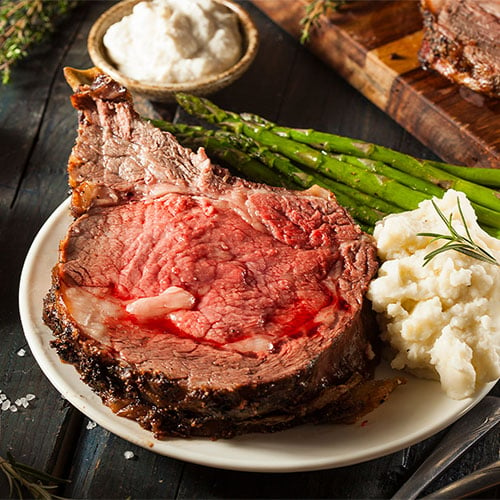
Derived from the rib section of the cow, the primal rib is the cut of beef that produces prime rib, which extends from the 6th to the 12th rib. This section is located between the chuck and the loin, closer to the front of the animal. What sets prime rib apart from other cuts of steak is its marbling, which refers to the intramuscular fat that is distributed throughout the meat. This marbling gives prime rib its exceptional flavor and tenderness, making it a favorite among steak lovers. When selecting prime rib, look for well-marbled meat with a good amount of fat evenly distributed throughout. This fat helps keep the meat moist and adds flavor during the cooking process.
Butcher shops typically sell prime rib as a bone-in roast, which adds to its juiciness. The bone acts as an insulator, helping retain moisture and imparting a depth of flavor to the meat. However, boneless prime rib is also available for those who prefer a more convenient option. Cooking prime rib is a culinary art that requires careful attention to detail. It is often prepared using dry-heat cooking methods such as roasting or grilling to enhance its natural flavors. Smoked prime rib is a show-stopping menu item. The slow cooking process allows the fat to render and baste the meat, resulting in a tender and juicy steak. Caterers often serve prime rib as a centerpiece for special occasions and holidays. It pairs well with a variety of side dishes, such as mashed potatoes, roasted vegetables, and a rich red wine sauce.
- Cut: Primal rib
- Flavor: Rich beefy flavor
- Cooking Methods: Roasting, smoking, or grilling
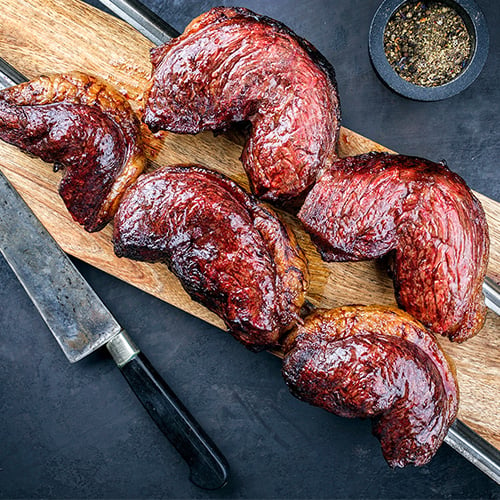
Picanha, also known as sirloin cap or rump cover, is a popular cut of steak that originates from Brazil and is popular throughout South America, particularly Argentina. Picanha comes from the top of the rump, specifically the cap muscle that surrounds the top sirloin. This muscle is well-marbled, which contributes to its rich, juicy flavor. One of the distinguishing features of picanha is the thick layer of fat that covers one side of the steak. This fat cap adds an incredible amount of flavor and moisture to the meat while it cooks. As the fat renders and melts during cooking, it bastes the steak, enhancing its taste and juiciness. This fat cap also helps protect the meat from drying out.
When cooking picanha, it is best to keep it simple. The rich flavor of the meat shines through with minimal seasoning. A popular way to prepare picanha is to season it with coarse salt and pepper, allowing the natural flavors to take center stage. Grilling is the preferred method for cooking picanha, as it allows the fat to render and create a delicious crust on the outside while keeping the inside tender and juicy. Picanha is often served sliced thin against the grain, which helps to further enhance its tenderness. This cut of steak is incredibly versatile and can be enjoyed on its own or as part of an array of asado (Argentinian BBQ) offerings. It pairs well with traditional Brazilian sides such as farofa (toasted cassava flour), feijoada (black bean stew), or even a simple chimichurri sauce.
- Cut: Rump
- Flavor: Buttery texture and lean beef flavor
- Cooking Methods: Grilling
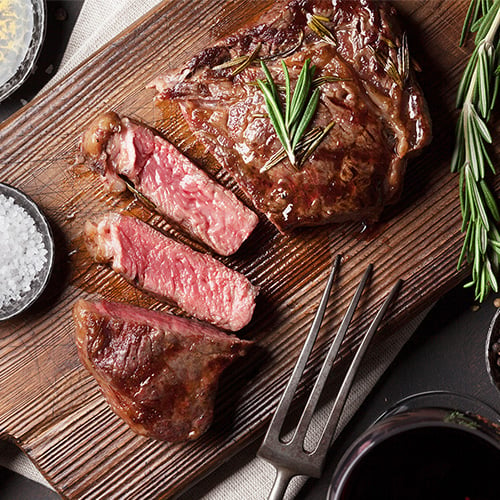
Derived from the rib section of the cow, ribeye is also referred to as a ribeye steak or a rib steak. One of its standout qualities is its marbling, which creates a rich, buttery flavor. It’s typically boneless, although bone-in ribeye steaks, also known as cowboy steaks, are also available. The bone-in ribeye adds an extra layer of flavor and juiciness to the meat. It is often preferred by those who enjoy a more rustic and traditional steak experience.
Ribeye steak is best suited for dry-heat cooking methods such as grilling, broiling, or pan-searing. The high-fat content of the ribeye helps keep the meat moist and tender during the cooking process. Whether cooked to rare, medium-rare, or medium, the ribeye delivers a succulent and flavorful eating experience. Its rich, juicy flavor pairs well with a variety of side dishes like grilled vegetables, sauteed mushrooms, and crispy onions.
- Cut: Rib
- Flavor: Buttery with rich beef flavor
- Cooking Methods: Grilling, broiling, pan-searing
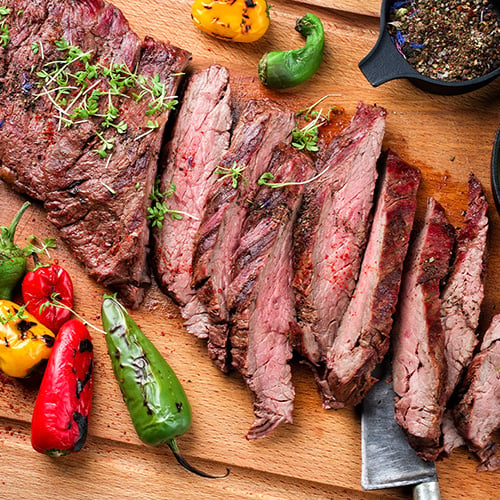
The flat iron steak comes from the shoulder region of the cow, specifically from the top blade muscle. It is named after its shape; it resembles a traditional flat iron used for ironing clothes. Flat iron steak is known for its tenderness and rich marbling. It offers a robust, beefy flavor that is often compared to a ribeye or a New York strip steak. Due to its popularity and tenderness, the flat iron steak offers a high-quality dining experience at a more affordable price compared to other premium cuts of steak.
One of the reasons flat iron steaks are so tender is they lack the connective tissue found in other tougher cuts of beef. However, it does have a thin strip of gristle running through the center, which you should remove before cooking to enhance the dining experience. Its versatile and can be cooked using various methods such as grilling, broiling, or pan-searing. Due to its tenderness, the perfect steak doneness for flat iron steak is between medium-rare or medium doneness to fully appreciate its flavor and texture. When serving the flat iron steak, slice it against the grain to maximize its tenderness and reduce chewiness.
- Cut: Top blade
- Flavor: Deep, rich beef
- Cooking Methods: Grilling, broiling, or pan-searing
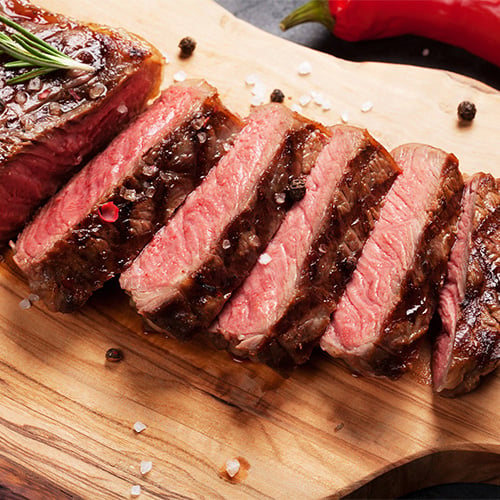
Tenderloin earned its name from its tender and buttery texture. The beef tenderloin is a cylindrical cut of beef that spans two primal cuts: the short loin and the sirloin. It is located beneath the ribs, next to the backbone. The tenderloin has two ends: the butt and the “tail.” The butt end is thicker and wider, while the tail end is narrower and tapers off. Both ends can be used to create delicious and tender steaks, although they may have slightly different shapes and sizes. The tenderloin is a non-weight-bearing muscle, which means it doesnt have to work as hard as other muscles in the cow. This lack of exercise contributes to its tender texture. Whether you grill, roast, or pan-sear the tenderloin, the key is to cook it slowly and at a low heat to achieve a perfect medium-rare doneness.
Butchers divide the tenderloin into three main cuts: the butt, the center cut, and the tail. Each of these cuts offers a slightly different flavor profile and shape, allowing chefs and restaurateurs to choose the one that best suits their culinary needs. The most popular and well-known portion is the center cut, which is often referred to as filet mignon. The larger end of the tenderloin, known as the butt end or head of the tenderloin, is the thickest part of the muscle. It is located closer to the rear of the animal and is known for its robust flavor. The butt is often used for roasts or beef Wellington. The tail is the narrowest and smallest portion of the tenderloin. It is located towards the rear of the animal and is known for its delicate flavor. The tail is often used for smaller steak portions, or it can be used in dishes that require thin slices of steak, like stir-fries or beef stroganoff.
- Cut: Loin Primal
- Flavor: Varies by the cut
- Cooking Methods: Roasting, smoking, reverse searing

What sets the Porterhouse steak apart is its unique composition. It comes from the rear end of the short loin, which is between the rib and sirloin sections of the beef. This positioning allows the porterhouse to contain two different cuts of steak: the center cut of tenderloin and the strip steak. The center cut of tenderloin, also known as filet mignon, is the most tender and delicate part of the beef. It is prized for its melt-in-your-mouth texture and subtle flavor. On the other hand, the strip steak, also known as the New York strip or sirloin strip, is a well-marbled cut with a rich, beefy flavor and a slightly firmer texture. Butchers typically cut the porterhouse steak to include a generous portion of both the tenderloin and the strip steak. The U.S. Department of Agriculture (USDA) specifies that for a steak to be labeled as a porterhouse, it must have a tenderloin section that measures at least 1 1/4 inches in width.
Due to its size and combination of two distinct cuts, the porterhouse steak is considered a showstopper on the plate. It is commonly served as a centerpiece for special occasions or shared between two people. When cooking the porterhouse steak, it is important to consider its size and composition. Due to the presence of the tenderloin, which is more delicate and cooks faster than the strip steak, we recommend using a cooking method that allows for even heat distribution. Grilling and broiling are popular methods that help to achieve a nicely charred exterior while maintaining a juicy and tender interior.
- Cut: Rear end of the short loin
- Flavor: The strip side is rich and beefy and the tenderloin portion is lean
- Cooking Methods: Sous vide, grilling, broiling

A T-bone steak is cut from the short loin of the cow, which is located in the upper middle section of its back. This area is known for its tenderness and marbling, which gives the T-bone steak its rich, juicy flavor. One of the main distinguishing features of the T-bone steak is the presence of the bone. The bone in the center of the steak is a combination of beef tenderloin and strip steak. On one side of the bone, you have the tenderloin, which is known for its tenderness and buttery texture. On its other side, you have the strip steak, also known as the New York strip or the Kansas City strip. The strip steak is slightly less tender than the tenderloin but makes up for it with its intense, beefy flavor.
When cooked properly, the T-bone steak offers the best of both worlds. The tenderloin section is incredibly tender and has a melt-in-your-mouth texture, while the strip steak section provides a satisfying chew and a robust umami flavor. The T-bone steak is typically cooked using dry heat methods such as grilling, broiling, or pan-searing to bring out its natural flavors and create a delicious crust on the outside. While both porterhouse and T-bone steaks include bones and are cut from the short loin, the porterhouse is cut from the rear of the short loin, and T-bone steaks are cut from the front of the short loin. T-bones contain a smaller section of the tenderloin than porterhouse steaks.
- Cut: Short Loin
- Flavor: The strip steak portion offers a robust, beefy flavor, and the filet mignon portion supplies a delicate, beefy flavor
- Cooking Methods: Grilling, broiling, or pan-searing
Avoid: Bottom round roast
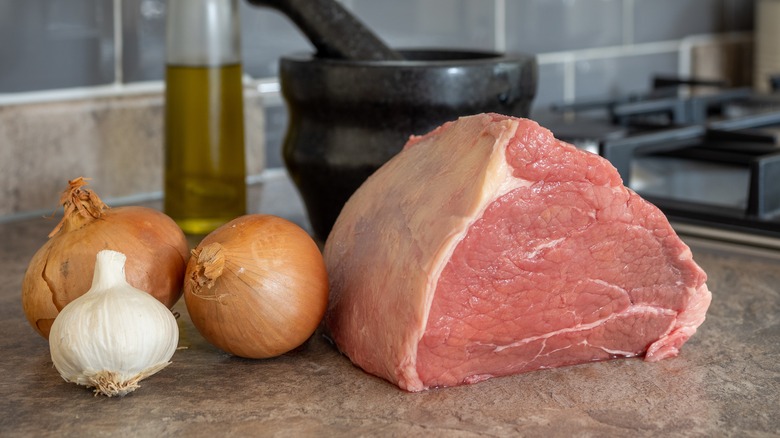
If you want to branch out beyond the most popular steaks and experiment with lesser-known cuts, it is useful to understand the difference between primal and subprimal cuts. Both Rosangela Teodoro and David Rose think that familiarizing yourself with them can be beneficial. “A primal is a side of beef that is separated or divided into seven manageable sections called primal: chuck, rib, loin, round, brisket, plate, and flank,” Teodoro explains.
The round primal comes from the back leg of the cow, and these cuts of beef are generally very lean, and pretty tough. “Id personally avoid the cheaper, tougher cuts that dont have a lot of strong flavors, like some of the bottom-round roasts,” Rose advises. “They tend to be tough and require long cooking times, and if not cooked right, they can end up dry or just bland.” Bottom round roast is also known as silverside in many countries including the U.K. and Australia.
Bottom round roast is not really the type of steak that you want to grill, as it benefits from a long cook at a low temperature. This will allow the connective tissue to soften, which can result in a delicious roast beef. However, as a steak to cook quickly on the grill, it is best avoided.

Looking for visual impact with your steak? Theres no better option than the striking tomahawk steak. Named after the tomahawk ax that it resembles, this cut of meat is thick and juicy. Served with the long bone French trimmed, you can choose to eat this particular cut using the bone as a handle, if you wish to give in to your primitive instinct.
David Rose is a fan. “My personal favorite is the tomahawk ribeye because it has beautiful marbling and is a showstopper with the rib bone.” The tomahawk is not a cut for the faint of heart, often weighing in at around two pounds. But that also makes it ideal for wowing a crowd — or yourself. “[Its] perfect for any celebratory occasion, or a great steak experience when you really want to treat yourself,” suggests Rose.
Rosangela Teodoro also appreciates this cut. “The flavor profile of the tomahawk is a slightly sweeter taste than their counterpart cowboy steak with a smaller bone in,” she says. “If you like to experience an umami taste, ask for a dry age.”
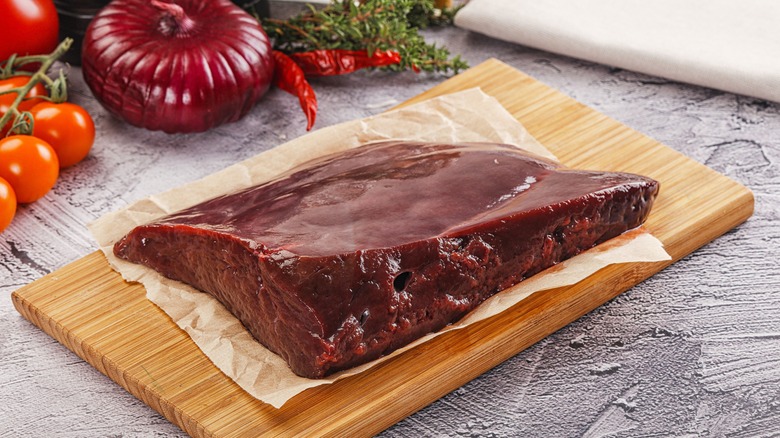
With the recent push against food waste and the increased popularity of nose-to-tail eating, offal has become more of a main feature in fine dining. Offal refers to the organ meats of the cow, and the best known meats include liver, kidneys, and tongue. It is often used in pate, and has a strong flavor that is much more robust than the steaks you may be used to. As an experienced butcher, Rosangela Teodoro advises against buying offal, not because of the flavor, but due to concerns over safety. “I would also not buy offal cuts, like liver or tongue, which require proper handling and preparation to ensure food safety and quality,” she advises.
If youre keen to try out a recipe with offal, find a butcher that you know is trustworthy and happy to talk to you about how the meat has been handled, as well as how you can prepare it at home. Properly cooked offal can be delicious, but if you cook it incorrectly, you are going to be disappointed by dry, grainy meat that will put you off for life!

Ribeye should be your cut of choice if youre willing to sacrifice a bit of tenderness in exchange for a seriously tasty steak. As one of the premium cuts of beef, it is pricey, but the beautiful marbling of fat makes it worth every penny. “[One of the] best is a Ribeye taken from the 6th to the 12th rib at the cow, with a long and exposed 7-inch bone in from the meat with the bone attached,” explains Rosangela Teodoro. “If you are looking to impress a carnivore, it is the way to go.”
Though most steak experts would advocate for cooking a good steak as rare as possible, ribeye shines when cooked medium-rare to medium, to allow the delicious fat to melt through the steak, while still remaining beautifully moist.
“Id say ribeye is my go-to for grilling because of its marbling,” admits David Rose. “The marbling helps keep the steak moist during the high heat of grilling, and the fat melts into the meat as it cooks, creating a rich, beefy flavor. Plus, its a thicker cut, which is perfect for grilling because it gives you enough time to develop a great sear without overcooking the inside.
Teodoro also points out that the quality of marbling in beef begins before the calf is even born. “To get great marbling requires time and managing every step of a calfs growth process,” she explains. “The more marbling is a reflection of a healthy and high quality cattle breed like Wagyu, feed that has nutrients, a cattles age, and worked muscles from being in the fields.”
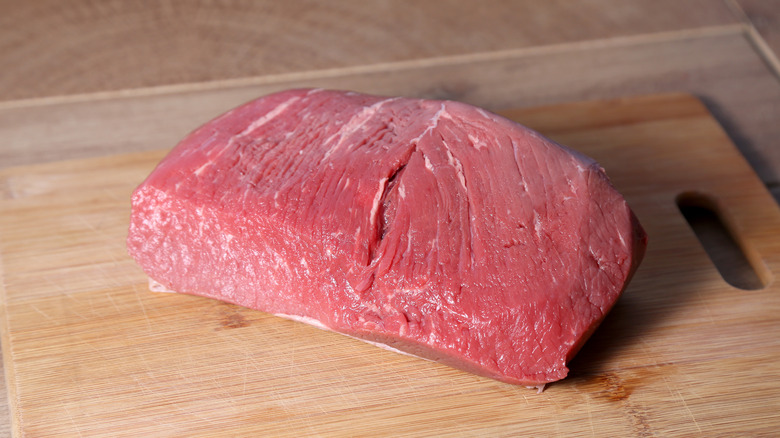
Next on our list of steak to avoid is another cut that comes from the round primal. This area of the cow does a lot of work, meaning that the muscles are very lean with little marbling. The rump roast can often have a fat cap on top, which can melt into the meat as it cooks, giving it more flavor than the other cuts from this primal. However David Rose recommends avoiding these cuts if youre looking for a steak that can be quickly cooked on the grill.
You dont have to avoid this cut completely, of course — it just means you need to know how to cook it to get the best out of it. The oven or slow cooker are the two main appliances for this type of meat, allowing you to cook it slowly at a low temperature until it becomes tender. While a rump roast can result in a lovely Sunday lunch, it is not a good choice of steak for grilling and serving with fries.

While it may not be as well-known as filet mignon or ribeye, if you are looking for a cut of steak that is both tender and packed with flavor, you should give picanha a try. “Picanha is a truly special cut of beef that holds a deep connection to Brazilian barbecue, or churrasco,” Rosangela Teodoro says. “What sets it apart is the thick layer of fat on top, which gives the meat its tenderness and rich flavor. Unlike other cuts that can be lean or tough, picanha is juicy and full of character, making it a favorite for grilling.”
The picanha is found at the top of the rump, which means it doesnt do as much work as some of the tougher cuts. It is a great cut to opt for if you are looking for a balance between texture and flavor. “The way the fat cap melts and bastes the meat as it cooks is the magic of picanha,” Teodoro explains. “Its a cut that allows for versatility. You can prepare it in different ways, but no matter how, you always end up with a delicious result.”
Cuts Of Steak Ranked From Worst To Best
FAQ
What is the highest quality cut of beef?
- Filet Mignon. Filet mignon is considered one of the most luxurious and expensive beef cuts prized for its tender and buttery texture. …
- Prime Rib. …
- Picanha. …
- Ribeye. …
- Flat Iron. …
- Tenderloin. …
- Porterhouse. …
- T-Bone.
Which cuts of beef are the most tender?
Black Angus filet mignon is the most tender cut of beef used for steaks. It comes from the smaller end of the tenderloin and should be well-marbled. You can grill it or cook it in a skillet and is best served blue rare or rare. Blue rare is a style of cooking that is becoming very popular for meat lovers.
What is the king of beef cuts?
The Ribeye is often hailed as the king of steak cuts, and for good reason. This cut is renowned for its rich marbling, which is the intricate network of fat that runs through the meat. As the Ribeye cooks, this marbling melts and infuses the steak with an unparalleled juiciness and depth of flavor.
What part of beef cuts are best?
The tenderloin (aka filet) is the best. It’s super tender and yummy but also lean. Ribeye is also very good but there is no cut better than a filet.
